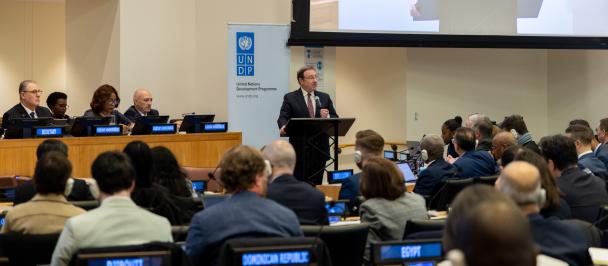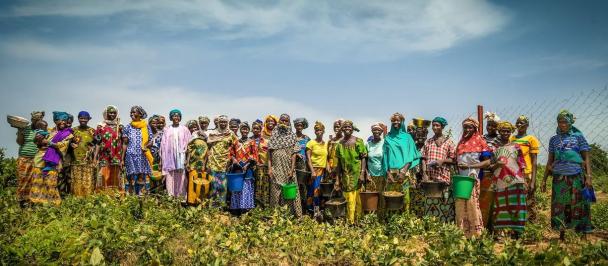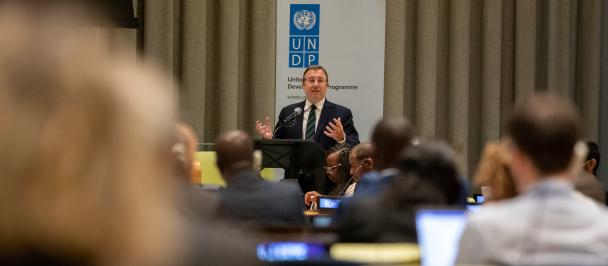Remarks at HLPF Side Event “From Commitment to Achievement: India’s experience in localizing the SDGs”. Organized by the Permanent Mission of India, the National Institute for the Transformation of India (NITI), and UN in India (RC).
India’s experience in localizing the SDGs
July 17, 2019
As prepared for delivery
• Thank you to Ambassador Syed Akbaruddin, Dr. Kumar and NITI Aayog for inviting me to provide some remarks. We have partnered for many years and our experiences in India are informing the way we work with other Middle-Income Countries. Among its many areas of progress, India is showing how remarkable progress can be made in reducing poverty, increasing life expectancy and providing access to education, all of which has accompanied India’s growth over the past few decades.
• The 2019 Multidimensional Poverty Index, which UNDP is launching tomorrow, is indicating how India has experienced the fastest absolute reductions in poverty, both in terms of incidence and intensity. India lifted 271 million people out of poverty between 2005/06 and 2015/16, with the poorest regions and groups experiencing the fastest reductions.
• Of course, a lot remains to be done. As the Secretary-General’s SDG Progress Report of this year noted, we need a “trajectory shift” in order to achieve the SDGs. We need to change the conversation and accelerate progress urgently.
• Again, we see India taking a leadership role here. India is a global example of how to bring sub-national level government on board and make the SDGs meaningful to people in their daily life. Enhancing local action to accelerate implementation is one of the key strategies for accelerating progress.
• Localizing the SDGs means more than just “landing” internationally agreed goals at the local level. It means making the aspirations of the SDGs become real to communities, households and individuals, particularly to those who are being left behind.
• As UNDP we are pleased to support such efforts, together with other development partners. Through numerous initiatives around the world, UNDP has developed a unique role and expertise on SDG localization and integration, which has been a key part of our support at national and state level in India, building on ongoing government-funded partnerships on SDG localization and state and district-level planning in eight states.
• For example, in the State of Haryana, the Government and UNDP partnered to establish an SDG Coordination Centre which is supporting the fast-tracking of multisectoral action and is being replicated in Punjab, Uttarakhand and Nagaland. In the State of Uttarakhand, an SDG monitoring framework has been institutionalized in all districts to track contributions of social schemes to the 2030 Agenda. And in Madhya Pradesh, an SDG syllabus developed with the Mahatma Gandhi Chitrakoot University has helped to train 30,000 Community Leaders to support preparation of village level SDG action plans.
• We are cross-fertilizing these experiences with those of other countries working on localization. For example, UNDP is working with the government in Indonesia to integrate SDGs into provincial and district planning; with the Philippines to build local government capacities and use local data for tracking progress towards the SDGs; with Ulaanbaatar City in Mongolia to develop a municipal SDG Roadmap.
• We are also working with India on changing the conversation on financing. In March, I had the honor of launching the “SDG financing facility” in Delhi with Dr. Rajiv Kumar. The Facility is a partnership aimed at supporting mobilization of resources for the SDGs working with the private sector and other stakeholders to develop SDG-aligned innovative financing instruments, including municipal and SDG bonds.
• The launch of the SDG financing facility in India is part of UNDP’s wider push globally to redirect financing from all sources towards sustainable development in order to achieve the SDGs. And as you know, this September the international community will rightly focus attention on the question of financing for development again, in parallel with the SDG Summit.
• Finally, we are working with India to bring innovation to policy making and implementation. NITI Aayog’s Aspirational Districts Programme, which is aimed at transforming the socio-economic status of priority districts, is a critical flagship for accelerating SDG achievements and ensuring that no one is left behind. UNDP is pleased to support this program including through the recently launched Accelerator Lab to leverage innovation.
Closing
• UNDP is committed to continuing to work closely with the Government, UN and other partners to expand learning from these partnerships which inspire our efforts to do development differently when transforming global commitments into local action - within India and around the world.

 Locations
Locations


